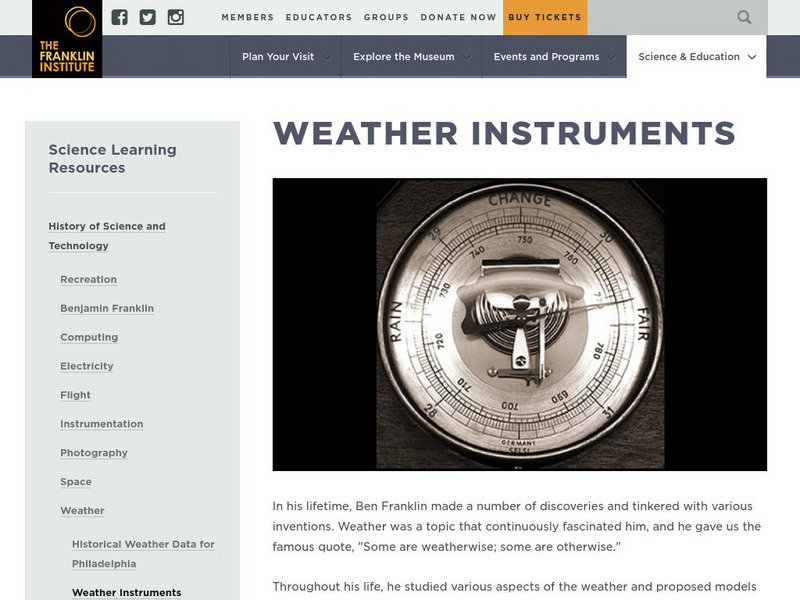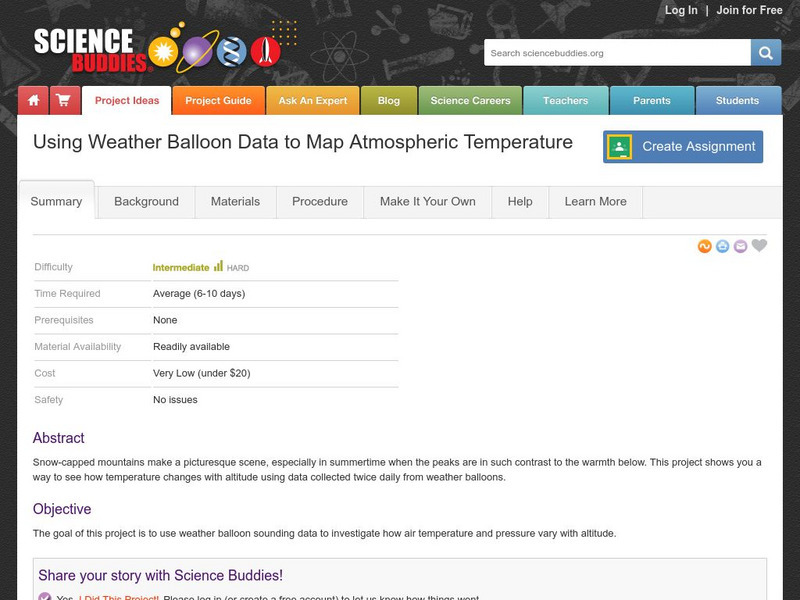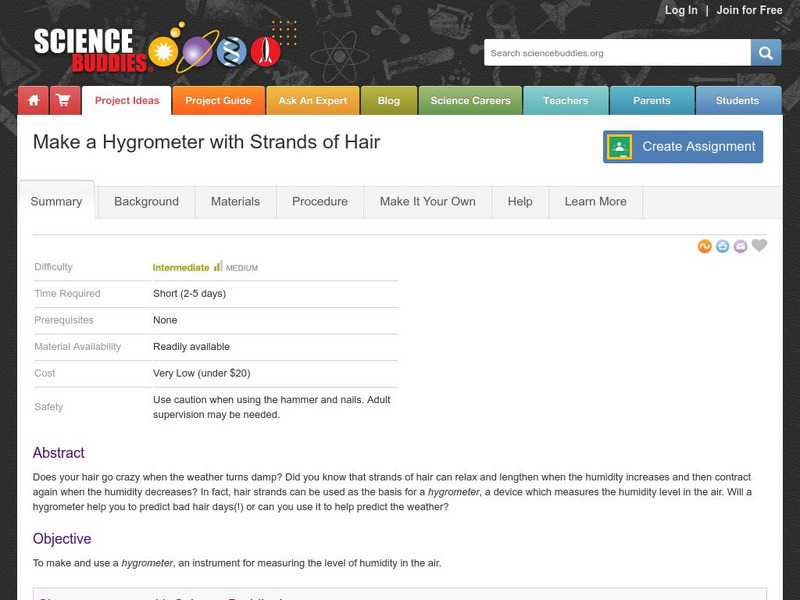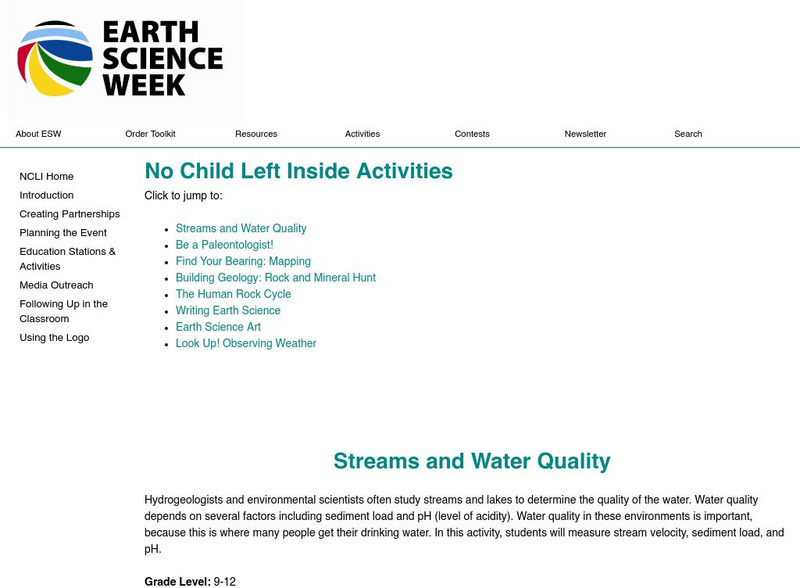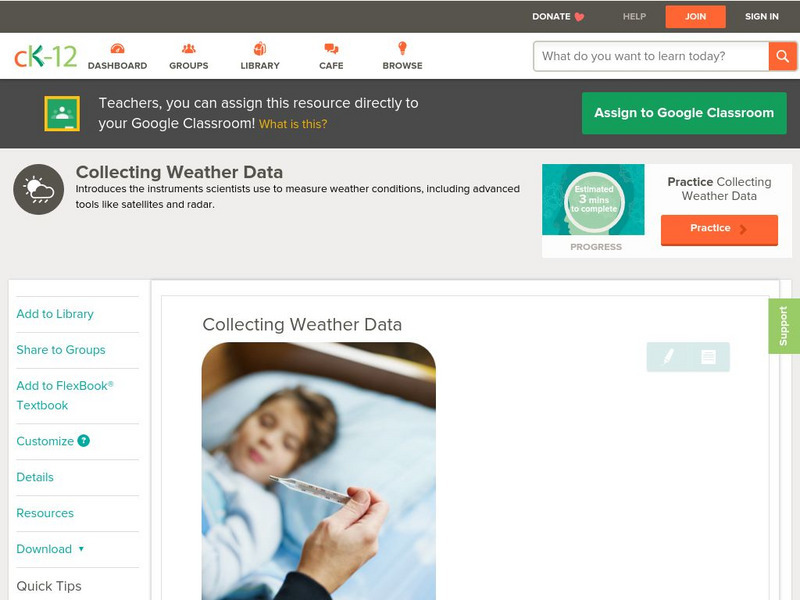The Franklin Institute
Franklin Institute: History of Science and Technology: Weather Instruments
A look back in time at weather instruments used in previous centuries. Includes pictures and descriptions of instruments from Franklin Institute's historical collection.
Other
Bright Hub: Types of Weather Instruments
There are a number of types of weather instruments located on the grounds of a weather station and used by meteorologists to predict the weather. These include the instruments that have been on the go for over a century with only the...
CK-12 Foundation
Ck 12: Third Grade Science: Earth Science: Weather Forecasting
[Free Registration/Login may be required to access all resource tools.] Read about how meteorologists predict the weather and how technology and computers are used to forecast the weather. Also discusses what weather maps show us.
Thomas Jefferson National Accelerator Facility
Jefferson Lab: Science Crossword Weather Instruments [Pdf]
Find out what you know about weather instruments by completing this crossword puzzle!
Science Buddies
Science Buddies: Using Weather Balloon Data to Map Atmospheric Temperature
Snow-capped mountains make a picturesque scene, especially in summertime when the peaks are in such contrast to the warmth below. This project shows you a way to see how temperature changes with altitude using data collected twice daily...
Other
Bright Hub: Technology Used to Collect Weather Data
Technology used to collect weather data employs a number of devices such as satellites and weather balloons to perform a very important function to our daily living; forecasting the weather.
Science Buddies
Science Buddies: Make Your Own Psychrometer
From the name, you might guess that a psychrometer is an instrument designed to measure your thoughts. Actually, it is an instrument that can help you forecast the weather. Read more to find out how it works.
Science Buddies
Science Buddies: How Does a Wind Meter Work?
On a windy day it is hard to keep your hat on. The power of the wind can even be strong enough to power large wind turbines to make electricity. In this experiment, find out how you can make your own instrument to measure the speed and...
CK-12 Foundation
Ck 12: Earth Science: Collecting Weather Data
[Free Registration/Login may be required to access all resource tools.] Describes the various instruments that scientists use to measure weather conditions, including advanced tools like satellites and radar.
CK-12 Foundation
Ck 12: Earth Science: Collecting Weather Data Study Guide
This comprehensive study guide covers the main terms and concepts needed for an earth science unit on collecting weather data. Review questions are included at the bottom of the study guide.
American Geosciences Institute
American Geosciences Institute: Earth Science Week: Build Your Own Weather Station
Students are guided in how to build their own weather station that will measure temperature, humidity, precipitation, atmospheric pressure, and wind direction and speed.
Science Struck
Science Struck: How to Make a Wind Vane in 5 Easy Steps
Explains how to make and install a weather vane using simple materials. Includes illustrations.
Science Struck
Science Struck: A Layman's Guide to How a Sling Psychrometer Works
A sling psychrometer is used to measure humidity levels. Read about its history, how it works, its design, and how to use it. Includes a relative humidity table.
E-learning for Kids
E Learning for Kids: Science: Titanic Shipwreck: How Can We Predict the Weather?
Join Tim on the Titanic Shipwreck to understand about weather predictions. Learn about weather forecasts and different instruments that help determine what the weather will be. Win stars for every correct answer and earn a certificate at...
Science Buddies
Science Buddies: Make a Hygrometer With Strands of Hair
Does your hair go crazy when the weather turns damp? Did you know that strands of hair can relax and lengthen when the humidity increases and then contract again when the humidity decreases? In fact, hair strands can be used as the basis...
CK-12 Foundation
Ck 12: Earth Science: Collecting Weather Data
[Free Registration/Login may be required to access all resource tools.] Describes the various instruments that scientists use to collect weather data.
American Geosciences Institute
American Geosciences Institute: Earth Science Week: Look Up! Observing Weather
To get a better idea of how meteorologists make weather predictions, students will begin their own weather journals and make rain gauges.
Science Buddies
Science Buddies: Measure the Pressure
Scientists have developed an instrument called a barometer that can measure atmospheric pressure. In this activity, you will find out how a barometer works by building one yourself.
Science Struck
Science Struck: Interpreting Barometric Pressure Readings
Explains how to read a barometer and interpret its meaning, as well as how the barometer was invented.
Other
California Energy Commission: Science Projects: Make an Anemometer
Nice brief description of this wind speed device and the directions to make your own.
CK-12 Foundation
Ck 12: Earth Science: Collecting Weather Data
[Free Registration/Login may be required to access all resource tools.] Describes the various instruments that scientists use to collect weather data.
Texas Instruments
Texas Instruments: Measuring Air Pressure
This activity is intended for an Introductory Meteorology class; an earth science elective intended for Juniors and Seniors. (It was orginally modifed from an Introductory Meteorology Laboratory Assigment taught to undergraduates at...
Science Struck
Science Struck: History and Working Principle of the Anemometer
Explains what an anemometer is used for and the different models that have been developed since it was first invented.
Science Struck
Science Struck: Barometer Units
Explains the different measurement units that are used in barometers and provides conversion tables.
